Amer Fort or Amber Fort is a fort located in Amer, Rajasthan, India. Amer is a town with an area of 4 square kilometres (1.5 sq mi) located 11 kilometres (6.8 mi) from Jaipur, the capital of Rajasthan. Located high on a hill, it is the principal tourist attraction in Jaipur. The town of Amer was originally built by Meenas, and later it was ruled by Raja Man Singh I. Amer Fort is known for its artistic style elements. With its large ramparts and series of gates and cobbled paths, the fort overlooks Maota Lake, which is the main source of water for the Amer Palace.
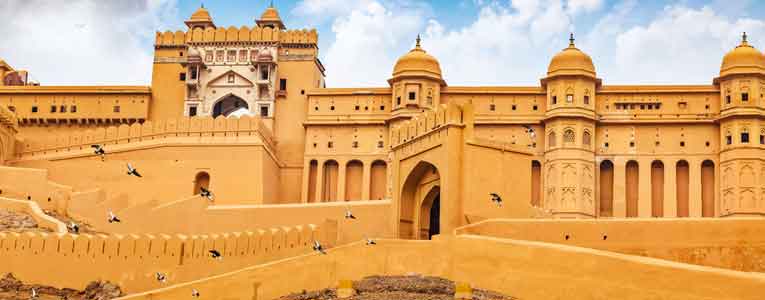
It consists of the Diwan-e-Aam, or "Hall of Public Audience", the Diwan-e-Khas, or "Hall of Private Audience", the Sheesh Mahal (mirror palace), or Jai Mandir, and the Sukh Niwas where a cool climate is artificially created by winds that blow over a water cascade within the palace. Hence, the Amer Fort is also popularly known as the Amer Palace. The palace was the residence of the Rajput Maharajas and their families.
Layout
The Palace is divided into six separate but main sections each with its own entry gate and courtyard. The main entry is through the Suraj Pol (Sun Gate) which leads to the first main courtyard. This was the place where armies would hold victory parades with their war bounty on their return from battles, which were also witnessed by the Royal family's womenfolk through the latticed windows. This gate was built exclusively and was provided with guards as it was the main entry into the palace. It faced east towards the rising sun, hence the name "". Royal cavalcades and dignitaries entered the palace through this gate.

First Courtyard
An impressive stairway from Jalebi Chowk leads into the main palace grounds. Here, at the entrance to the right of the stairway steps is the Sila Devi temple where the Rajput Maharajas worshipped, starting with Maharaja Mansingh in the 16th century until the 1980s, when the animal sacrifice ritual (sacrifice of a buffalo) practiced by the royalty was stopped.
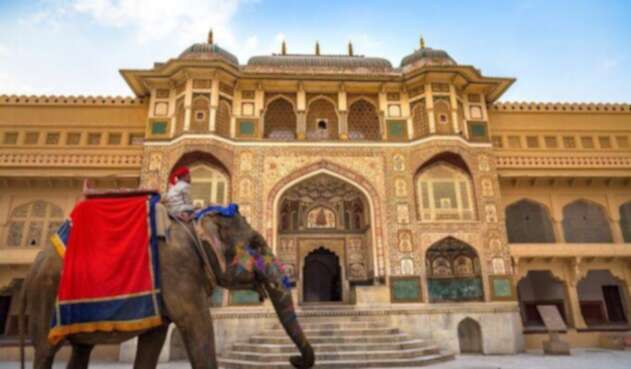
Second Courtyard
The second courtyard, up the main stairway of the first level courtyard, houses the Diwan-i-Aam or the Public Audience Hall. Built with a double row of columns, the Diwan-i-Aam is a raised platform with 27 colonnades, each of which is mounted with an elephant-shaped capital, with galleries above it.
As the name suggests, the Raja (King) held audience here to hear and receive petitions from the public.
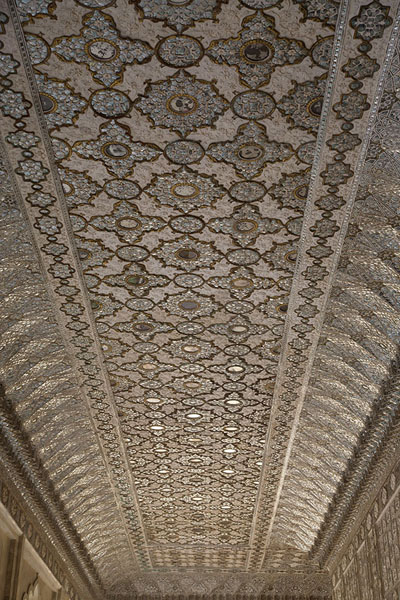
Mirrored ceiling in the Mirror Palace
Third Courtyard
The third courtyard is where the private quarters of the Maharaja, his family and attendants were located. This courtyard is entered through the Ganesh Pol or Ganesh Gate, which is embellished with mosaics and sculptures. The courtyard has two buildings, one opposite to the other, separated by a garden laid in the fashion of the Mughal Gardens. The building to the left of the entrance gate is called the Jai Mandir, which is exquisitely embellished with glass inlaid panels and multi-mirrored ceilings. The mirrors are of convex shape and designed with colored foil and paint which would glitter bright under candlelight at the time it was in use. Also known as Sheesh Mahal (mirror palace), the mirror mosaics and colored glasses were a "glittering jewel box in flickering candlelight". Sheesh mahal was built by King Man Singh in the 16th century and completed in 1727. It is also the foundation year of Jaipur state. However, most of this work was allowed to deteriorate during the period 1970–80 but has since then been in the process of restoration and renovation. The walls around the hall hold carved marble relief panels. The hall provides enchanting vistas of the Maota Lake.
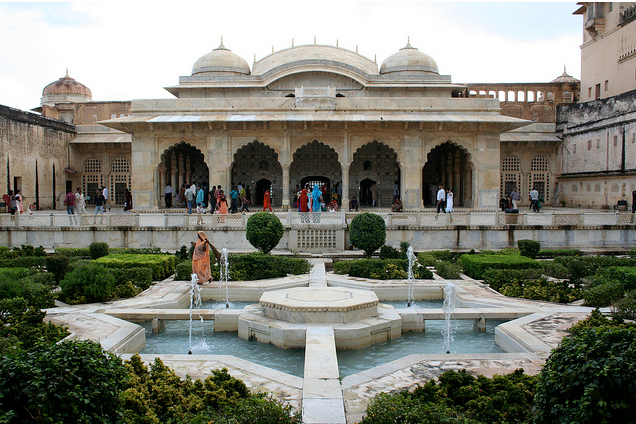
On top of Jai Mandir is Jas Mandir, a hall of private audience with floral glass inlays and alabaster relief work.

Magic Flower
A particular attraction here is the "magic flower" carved marble panel at the base of one of the pillars around the mirror palace depicting two hovering butterflies; the flower has seven unique designs including a fishtail, lotus, hooded cobra, elephant trunk, lion's tail, cob of corn, and scorpion, each one of which is visible by a special way of partially hiding the panel with the hands.

Garden
The garden, located between the Jai Mandir on the east and the Sukh Niwas on the west, both built on high platforms in the third courtyard, was built by Mirza Raja Jai Singh (1623–68). It is patterned on the lines of the Chahar Bagh or Mughal Garden. It is in a sunken bed, shaped in a hexagonal design. It is laid out with narrow channels lined with marble around a star-shaped pool with a fountain at the center. Water for the garden flows in cascades through channels from the Sukh Niwas and also from the cascade channels called the "chini khana niches" that originate on the terrace of the Jai Mandir.

Tripolia Gate
Tripolia gate means three gates. It is access to the palace from the west. It opens in three directions, one to the Jaleb Chowk, another to the Man Singh Palace and the third one to the Zenana Deorhi on the south.
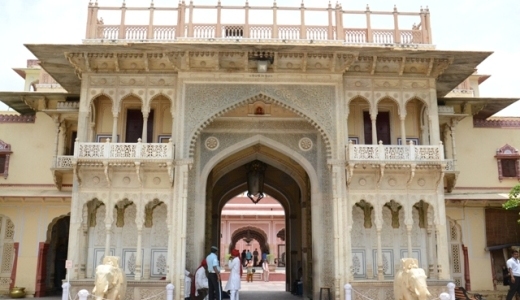
Lion gate
The Lion Gate, the premier gate, was once a guarded gate; it leads to the private quarters in the palace premises and is titled 'Lion Gate' to suggest strength. Built during the reign of Sawai Jai Singh (1699–1743 AD), it is covered with frescoes; its alignment is zigzag, probably made so from security considerations to attack intruders.

Fourth courtyard
The fourth courtyard is where the Zenana (Royal family women, including concubines or mistresses) lived. This courtyard has many living rooms where the queens resided and who were visited by the king at his choice without being found out as to which queen he was visiting, as all the rooms open into a common corridor.
